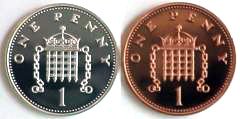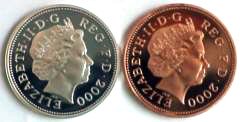| The Very Highest Quality Coins... |
| Magnetic Money |
|

|
|
|

|
|
|

|
|
|
Copper Plated Steel
The reason some coins are magnetic is because they are made of steel, which is magnetic, rather than bronze, which is not.
In 1992, the Royal Mint started to produce pennies and twopences made of copper-plated steel instead of bronze (copper has not been used since 1860!). The 1992 coins can be found in both bronze and copper-plated steel. This was done, as in many other countries, to reduce production costs of coins. Most people don't take much notice of the coins in their change, and the media don't usually bother reporting such changes at the time, presumably because it's not the right kind of news to sell newspapers. It's also possible that the Royal Mint or the Government don't bother to promote news about such changes, because there is no profit or votes in it. When people do hear such news, it's also the sort of news they tend to forget about, because it doesn't appear to affect them immediately.
Does the Plating Wear Off?
Yes of course it does. All plating will wear off eventually, leaving most of our "copper" coins looking gray.
Why Has It Lasted So Long?
If steel pennies have been made since 1992, why has it taken 8 years for the plating to wear off, and people to start noticing?
The plating is applied to the coin blanks before they are struck. The high pressure used to stamp the coins forces an extremely close bond between the substrate and the plating. Striking also generates considerable heat, and the high temperature produced further helps the bonding process. The result is that the plating lasts many times longer than it would if the coins were plated after striking.
How To Check - Silver or Steel (or Bronze)
Easy - just use a magnet!
Steel is magnetic, bronze and silver are not magnetic.
So if you have a copper or silver coloured penny which is magnetic, it cannot be silver or bronze, it must be made of steel.
Similarly, if it is non-magnetic, it is made of silver, bronze. cupro-nickel, aluminium, or some other alloy, but not steel.
It is easy to tell silver from bronze because they are different colours.
Can't Find a Magnet - Use Your Fridge!
Most modern refrigerators have magnetic seals around the inside of their doors.
By holding your coins to the magnetic strip, you will easily be able to tell which is which. Many people already know this because they recycle aluminium cans.
As refrigerators are not easy to carry round in your pocket, if you wish to check your change while you out shopping, we suggest buying a pocket size magnet.
We also get asked about "silver" pennies people have found in change, these are usually copper plated steel ones which have lost their plating. For more information about them, you could take a look at our Silver Pennies in Change page.
If you read our History of the Penny page, you can learn even more about pennies.
You may wish to visit some of our other pages:
Value of my Coin. What's it Worth?
British Coin Denominations. What's a Groat,? etc.
Common Names of British Coins. What's a Tanner?
Do you have a query about our coins?
| ...at the Lowest Possible Price |
|
32 - 36 Harrowside, Blackpool, Lancashire, FY4 1RJ, England. Telephone (44) - (0) 1253 - 343081 ; Fax 408058; E-mail: The URL for our main page is: https://24carat.co.uk | Chard(1964) Ltd |